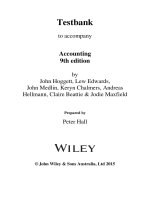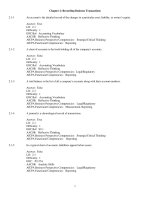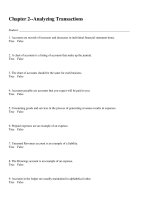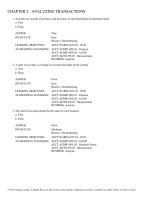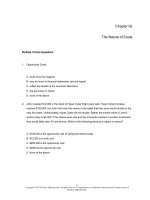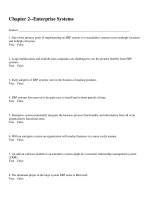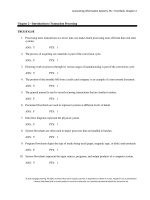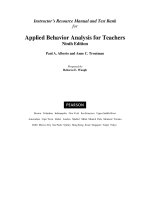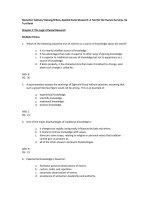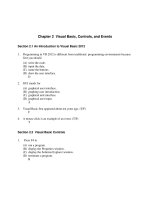Accounting 9th edition horngren test bank
Bạn đang xem bản rút gọn của tài liệu. Xem và tải ngay bản đầy đủ của tài liệu tại đây (349.58 KB, 69 trang )
Chapter 2: Recording Business Transactions
2.1-1
An account is the detailed record of the changes in a particular asset, liability, or owner’s equity.
Answer: True
LO: 2-1
Difficulty: 1
EOC Ref: Accounting Vocabulary
AACSB: Reflective Thinking
AICPA Business Perspective Competencies: Strategic/Critical Thinking
AICPA Functional Competencies: Reporting
2.1-2
A chart of accounts is the book holding all of the company's accounts.
Answer: False
LO: 2-1
Difficulty: 1
EOC Ref: Accounting Vocabulary
AACSB: Reflective Thinking
AICPA Business Perspective Competencies: Legal/Regulatory
AICPA Functional Competencies: Reporting
2.1-3
A trial balance is the list of all a company's accounts along with their account numbers.
Answer: False
LO: 2-1
Difficulty: 1
EOC Ref: Accounting Vocabulary
AACSB: Reflective Thinking
AICPA Business Perspective Competencies: Legal/Regulatory
AICPA Functional Competencies: Measurement, Reporting
2.1-4
A journal is a chronological record of transactions.
Answer: True
LO: 2-1
Difficulty: 1
EOC Ref: S2-1
AACSB: Reflective Thinking
AICPA Business Perspective Competencies: Strategic/Critical Thinking
AICPA Functional Competencies: Reporting
2.1-5
In a typical chart of accounts, liabilities appear before assets.
Answer: False
LO: 2-1
Difficulty: 1
EOC: P2-27A
AACSB: Analytic Skills
AICPA Business Perspective Competencies: Legal/Regulatory
AICPA Functional Competencies: Reporting
1
2.1-6
A trial balance is a list of all of the accounts with their balances.
Answer: True
LO: 2-1
Difficulty: 1
EOC Ref: Accounting Vocabulary
AACSB: Reflective Thinking
AICPA Business Perspective Competencies: Legal/Regulatory
AICPA Functional Competencies: Reporting
2.1-7
Expenses are increases in owner’s equity caused by providing goods or services for customers.
Answer: False
LO: 2-1
Difficulty: 1
EOC Ref: S2-2
AACSB: Reflective Thinking
AICPA Business Perspective Competencies: Legal/Regulatory
AICPA Functional Competencies: Reporting
2.1-8
Which of the following accounts is NOT an example of an asset?
A) Accounts receivable
B) Cash
C) Building
D) Notes payable
Answer: D
LO: 2-1
Difficulty: 1
EOC Ref: S2-3
AACSB: Analytic Skills
AICPA Business Perspective Competencies: Legal/Regulatory
AICPA Functional Competencies: Reporting
2.1-9
Which of the following accounts is NOT an example of a liability?
A) Wages payable
B) Notes payable
C) Accounts payable
D) Accounts receivable
Answer: D
LO: 2-1
Difficulty: 1
EOC Ref: S2-3
AACSB: Analytic Skills
AICPA Business Perspective Competencies: Legal/Regulatory
AICPA Functional Competencies: Reporting
2
2.1-10
Which of the following accounts is an example of an owner’s equity account?
A) Accounts payable
B) Equipment
C) Cash
D) Drawing
Answer: D
LO: 2-1
Difficulty: 1
EOC Ref: S2-3
AACSB: Analytic Skills
AICPA Business Perspective Competencies: Legal/Regulatory
AICPA Functional Competencies: Reporting
2.1-11
Accountants first record transactions in the:
A) chart of accounts.
B) trial balance.
C) journal.
D) ledger.
Answer: C
LO: 2-1
Difficulty: 1
EOC Ref: S2-4
AACSB: Analytic Skills
AICPA Business Perspective Competencies: Strategic/Critical Thinking
AICPA Functional Competencies: Reporting
2.1-12
Which of the following accounts is an asset?
A) Salary expense
B) Accounts payable
C) Service revenue
D) Prepaid expenses
Answer: D
LO: 2-1
Difficulty: 1
EOC Ref: S2-3
AACSB: Analytic Skills
AICPA Business Perspective Competencies: Legal/Regulatory
AICPA Functional Competencies: Reporting
3
2.1-13
Which of the following accounts is a liability?
A) Accounts payable
B) Prepaid expenses
C) Salary expense
D) Service revenue
Answer: A
LO: 2-1
Difficulty: 1
EOC Ref: S2-3
AACSB: Analytic Skills
AICPA Business Perspective Competencies: Legal/Regulatory
AICPA Functional Competencies: Reporting
2.1-14
Which of the following accounts is an owner’s equity account?
A) Accrued liability
B) Accounts payable
C) Prepaid expense
D) Capital
Answer: D
LO: 2-1
Difficulty: 1
EOC Ref: S2-3
AACSB: Analytic Skills
AICPA Business Perspective Competencies: Legal/Regulatory
AICPA Functional Competencies: Reporting
2.1-15
Prepaid expenses are recorded as:
A) assets.
B) liabilities.
C) debits and credits.
D) owner’s equity.
Answer: A
LO: 2-1
Difficulty: 1
EOC: S2-3
AACSB: Analytic Skills
AICPA Business Perspective Competencies: Legal/Regulatory
AICPA Functional Competencies: Reporting
4
2.1-16
In a typical chart of accounts, what information is provided along with the account name?
A) Account balance
B) Account number
C) Dates of transactions
D) Transaction amounts
Answer: B
LO: 2-1
Difficulty: 1
EOC: P2-27A
AACSB: Analytic Skills
AICPA Business Perspective Competencies: Legal/Regulatory
AICPA Functional Competencies: Reporting
2.1-17
Which of the following are accrued liabilities?
A) Taxes payable
B) Interest payable
C) Salary payable
D) All of the above
Answer: D
LO: 2-1
Difficulty: 1
EOC: S2-1
AACSB: Reflective Thinking
AICPA Business Perspective Competencies: Legal/Regulatory
AICPA Functional Competencies: Reporting
2.1-18
Which of the following accounts is an example of a liability?
A) Service revenue
B) Building
C) Accounts receivable
D) Notes payable
Answer: D
LO: 2-1
Difficulty: 1
EOC Ref: S2-3
AACSB: Reflective Thinking
AICPA Business Perspective Competencies: Legal/Regulatory
AICPA Functional Competencies: Reporting
2.1-19
A listing of all account titles in numerical order is a(n):
A) ledger.
B) journal.
C) income statement.
D) chart of accounts.
Answer: D
LO: 2-1
Difficulty: 1
EOC: Accounting Vocabulary
AACSB: Reflective Thinking
AICPA Business Perspective Competencies: Legal/Regulatory
AICPA Functional Competencies: Reporting
5
2.1-20
Which of the following accounts is an asset?
A) Cash
B) Notes payable
C) Drawing
D) Expenses
Answer: A
LO: 2-1
Difficulty: 2
EOC: S2-3
AACSB: Reflective Thinking
AICPA Business Perspective Competencies: Legal/Regulatory
AICPA Functional Competencies: Reporting
2.1-21
Which of the following is NOT part of owner’s equity?
A) Accounts receivable
B) Capital
C) Notes payable
D) Both A and C
Answer: D
LO: 2-1
Difficulty: 1
EOC: S2-3
AACSB: Reflective Thinking
AICPA Business Perspective Competencies: Legal/Regulatory
AICPA Functional Competencies: Reporting
2.1-22
A book holding all of the accounts is called the:
A) ledger.
B) journal.
C) income statement.
D) balance sheet.
Answer: A
LO: 2-1
Difficulty: 2
EOC: Accounting Vocabulary
AACSB: Reflective Thinking
AICPA Business Perspective Competencies: Legal/Regulatory
AICPA Functional Competencies: Reporting
6
2.1-23
Which of the following is the detailed record of the changes in a particular asset, liability, or
owner’s equity?
A) Journal
B) Trial balance
C) Ledger
D) Account
Answer: D
LO: 2-1
Difficulty: 1
EOC Ref: Accounting Vocabulary
AACSB: Reflective Thinking
AICPA Business Perspective Competencies: Legal/RegulatoryAICPA Functional Competencies:
Measurement, Reporting
2.2-1
Debit refers to the right side of the T-account, and credit refers to the left side.
Answer: False
LO: 2-2
Difficulty: 1
EOC Ref: S2-2
AACSB: Reflective Thinking
AICPA Business Perspective Competencies: Strategic/Critical Thinking
AICPA Functional Competencies: Measurement
2.2-2
In the standard accounting system, we use double entry accounting, which means we record the dual
effects of each transaction.
Answer: True
LO: 2-2
Difficulty: 1
EOC Ref: Accounting Vocabulary
AACSB: Reflective Thinking
AICPA Business Perspective Competencies: Strategic/Critical Thinking
AICPA Functional Competencies: Measurement
2.2-3
An asset account is increased by a debit.
Answer: True
LO: 2-2
Difficulty: 1
EOC Ref: S2-2
AACSB: Reflective Thinking
AICPA Business Perspective Competencies: Strategic/Critical Thinking
AICPA Functional Competencies: Measurement
7
2.2-4
The owner’s capital account is increased by a debit.
Answer: False
LO: 2-2
Difficulty: 1
EOC Ref: S2-2
AACSB: Analytic Skills
AICPA Business Perspective Competencies: Strategic/Critical Thinking
AICPA Functional Competencies: Measurement
2.2-5
The drawing (withdrawals) account is increased by a debit.
Answer: True
LO: 2-2
Difficulty: 1
EOC Ref: S2-2
AACSB: Analytic Skills
AICPA Business Perspective Competencies: Strategic/Critical Thinking
AICPA Functional Competencies: Measurement
2.2-6
A liability account is increased by a debit.
Answer: False
LO: 2-2
Difficulty: 1
EOC Ref: S2-2
AACSB: Analytic Skills
AICPA Business Perspective Competencies: Strategic/Critical Thinking
AICPA Functional Competencies: Measurement
2.2-7
Which of the following accounts increases with a credit?
A) Cash
B) Capital
C) Accounts receivable
D) Prepaid expenses
Answer: B
LO: 2-2
Difficulty: 1
EOC Ref: S2-2
AACSB: Analytic Skills
AICPA Business Perspective Competencies: Strategic/Critical Thinking
AICPA Functional Competencies: Measurement
8
2.2-8
Which of the following accounts decreases with a credit?
A) Cash
B) Capital
C) Accounts payable
D) Notes Payable
Answer: A
LO: 2-2
Difficulty: 1
EOC Ref: S2-2
AACSB: Analytic Skills
AICPA Business Perspective Competencies: Strategic/Critical Thinking
AICPA Functional Competencies: Measurement
2.2-9
Which of the following accounts increases with a debit?
A) Cash
B) Interest payable
C) Accounts payable
D) Capital
Answer: A
LO: 2-2
Difficulty: 1
EOC Ref: S2-2
AACSB: Analytic Skills
AICPA Business Perspective Competencies: Strategic/Critical Thinking
AICPA Functional Competencies: Measurement
2.2-10
Which of the following accounts decreases with a debit?
A) Notes payable
B) Prepaid insurance
C) Cash
D) Land
Answer: A
LO: 2-2
Difficulty: 1
EOC Ref: S2-2
AACSB: Analytic Skills
AICPA Business Perspective Competencies: Strategic/Critical Thinking
AICPA Functional Competencies: Measurement
2.3-1
An account that normally has a debit balance may occasionally have a credit balance.
Answer: True
LO: 2-3
Difficulty: 1
EOC Ref: S2-2
AACSB: Analytic Skills
AICPA Business Perspective Competencies: Strategic/Critical Thinking
AICPA Functional Competencies: Measurement
9
2.3-2
Assets, Drawing, and Expenses have a normal balance on the debit side.
Answer: True
LO: 2-3
Difficulty: 1
EOC: S2-3
AACSB: Analytic Skills
AICPA Business Perspective Competencies: Strategic/Critical Thinking
AICPA Functional Competencies: Measurement
2.3-3
For assets and expenses, a debit increases the account.
Answer: True
LO: 2-3
Difficulty: 1
EOC Ref: S2-3
AACSB: Analytic Skills
AICPA Business Perspective Competencies: Strategic/Critical Thinking
AICPA Functional Competencies: Measurement
2.3-4
For liabilities and revenues, a debit increases the account.
Answer: False
LO: 2-3
Difficulty: 1
EOC Ref: S2-2
AACSB: Analytic Skills
AICPA Business Perspective Competencies: Strategic/Critical Thinking
AICPA Functional Competencies: Strategic/Critical Thinking
2.3-5
When recording a transaction in a journal, the credit side is entered first, followed by the debit side.
Answer: False
LO: 2-3
Difficulty: 1
EOC Ref: S2-5
AACSB: Reflective Thinking
AICPA Business Perspective Competencies: Strategic/Critical Thinking
AICPA Functional Competencies: Reporting
2.3-6
Both the date of the transaction and a brief description are included in a journal entry.
Answer: True
LO: 2-3
Difficulty: 1
EOC Ref: S2-5
AACSB: Reflective Thinking
AICPA Business Perspective Competencies: Strategic/Critical Thinking
AICPA Functional Competencies: Reporting
10
2.3-7
The process of copying from the journal to the ledger is called posting.
Answer: True
LO: 2-3
Difficulty: 1
EOC Ref: S2-1
AACSB: Reflective Thinking
AICPA Business Perspective Competencies: Strategic/Critical Thinking
AICPA Functional Competencies: Reporting
2.3-8
A journal entry includes BOTH debit and credit amounts.
Answer: True
LO: 2-3
Difficulty: 1
EOC Ref: S2-6
AACSB: Reflective Thinking
AICPA Business Perspective Competencies: Strategic/Critical Thinking
AICPA Functional Competencies: Reporting
2.3-9
In the accounting system, the first place that transactions are recorded is the ledger.
Answer: False
LO: 2-3
Difficulty: 1
EOC Ref: S2-1
AACSB: Reflective Thinking
AICPA Business Perspective Competencies: Strategic/Critical Thinking
AICPA Functional Competencies: Measurement, Reporting
2.3-10
Which of the following groups of accounts BOTH normally have a debit balance?
A) Assets and Expenses
B) Revenues and Expenses
C) Liabilities and Owner’s equity
D) Assets and Liabilities
Answer: A
LO: 2-3
Difficulty: 1
EOC Ref: S2-4
AACSB: Analytic Skills
AICPA Business Perspective Competencies: Strategic/Critical Thinking
AICPA Functional Competencies: Measurement
11
2.3-11
Which of the following groups of accounts BOTH normally have a credit balance?
A) Assets and Expenses
B) Revenues and Expenses
C) Liabilities and Owner’s equity
D) Assets and Liabilities
Answer: C
LO: 2-3
Difficulty: 1
EOC Ref: S2-4
AACSB: Analytic Skills
AICPA Business Perspective Competencies: Strategic/Critical Thinking
AICPA Functional Competencies: Measurement
2.3-12
Journalizing a transaction means:
A) calculating the balance in an account.
B) finding the account number in the chart of accounts.
C) recording the transaction, including a brief explanation.
D) copying the information from the journal to the ledger.
Answer: C
LO: 2-3
Difficulty: 1
EOC Ref: S2-5
AACSB: Analytic Skills
AICPA Business Perspective Competencies: Strategic/Critical Thinking
AICPA Functional Competencies: Measurement
2.3-13
Posting a transaction means:
A) calculating the balance in an account.
B) finding the account number in the chart of accounts.
C) recording the transaction including a brief explanation.
D) copying the information from the journal to the ledger.
Answer: D
LO: 2-3
Difficulty: 1
EOC Ref: S2-7
AACSB: Analytic Skills
AICPA Business Perspective Competencies: Strategic/Critical Thinking
AICPA Functional Competencies: Measurement
12
2.3-14
Which of the following statements about expenses is CORRECT?
A) Expenses increase owner’s equity, so an expense account's normal balance is a credit balance.
B) Expenses decrease owner’s equity, so an expense account's normal balance is a credit balance.
C) Expenses increase owner’s equity, so an expense account's normal balance is a debit balance.
D) Expenses decrease owner’s equity, so an expense account's normal balance is a debit balance.
Answer: D
LO: 2-3
Difficulty: 2
EOC Ref: S2-3
AACSB: Analytic Skills
AICPA Business Perspective Competencies: Strategic/Critical Thinking
AICPA Functional Competencies: Measurement
2.3-15
The balance of an account is the:
A) amount remaining in an account.
B) account number, as shown in the chart of accounts.
C) sum of the debits only.
D) sum of the credits only.
Answer: A
LO: 2-3
Difficulty: 1
EOC Ref: S2-3
AACSB: Analytic Skills
AICPA Business Perspective Competencies: Strategic/Critical Thinking
AICPA Functional Competencies: Measurement
2.3-16
For Accounts receivable, the category of account and its normal balance are:
A) Owner’s equity and a credit balance.
B) Assets and a debit balance.
C) Liabilities and a credit balance.
D) Assets and a credit balance.
Answer: B
LO: 2-3
Difficulty: 2
EOC Ref: S2-3
AACSB: Analytic Skills
AICPA Business Perspective Competencies: Strategic/Critical Thinking
AICPA Functional Competencies: Measurement
13
2.3-17
For Accounts payable, the category of account and its normal balance are:
A) Owner’s equity and a credit balance.
B) Assets and a debit balance.
C) Liabilities and a credit balance.
D) Assets and a credit balance.
Answer: C
LO: 2-3
Difficulty: 2
EOC Ref: S2-3
AACSB: Analytic Skills
AICPA Business Perspective Competencies: Strategic/Critical Thinking
AICPA Functional Competencies: Measurement
2.3-18
For Cash, the category of account and its normal balance are:
A) Assets and a debit balance.
B) Liabilities and a credit balance.
C) Owner’s equity and a credit balance.
D) Assets and a credit balance.
Answer: A
LO: 2-3
Difficulty: 2
EOC Ref: S2-3
AACSB: Analytic Skills
AICPA Business Perspective Competencies: Strategic/Critical Thinking
AICPA Functional Competencies: Measurement
2.3-19
For Capital, the category of account and its normal balance are:
A) Owner’s equity and a credit balance.
B) Assets and a debit balance.
C) Liabilities and a credit balance.
D) Owner’s equity and a debit balance.
Answer: A
LO: 2-3
Difficulty: 2
EOC Ref: S2-3
AACSB: Analytic Skills
AICPA Business Perspective Competencies: Strategic/Critical Thinking
AICPA Functional Competencies: Measurement
2.3-20
For Supplies, the category of account and its normal balance are:
A) Owner’s equity and a credit balance.
B) Assets and a debit balance.
C) Liabilities and a credit balance.
D) Assets and a credit balance.
Answer: B
LO: 2-3
Difficulty: 2
EOC Ref: S2-3
AACSB: Analytic Skills
AICPA Business Perspective Competencies: Strategic/Critical Thinking
AICPA Functional Competencies: Measurement
14
2.3-21
For Salary Payable, the category of account and its normal balance are:
A) Owner’s equity and a credit balance.
B) Assets and a debit balance.
C) Liabilities and a credit balance.
D) Assets and a credit balance.
Answer: C
LO: 2-3
Difficulty: 2
EOC Ref: S2-3
AACSB: Analytic Skills
AICPA Business Perspective Competencies: Strategic/Critical Thinking
AICPA Functional Competencies: Measurement
2.3-22
For Expenses, the category of account and its normal balance are:
A) Owner’s equity and a credit balance.
B) Assets and a debit balance.
C) Liabilities and a credit balance.
D) Owner’s equity and a debit balance.
Answer: D
LO: 2-3
Difficulty: 2
EOC Ref: S2-3
AACSB: Analytic Skills
AICPA Business Perspective Competencies: Strategic/Critical Thinking
AICPA Functional Competencies: Measurement
2.3-23
For Revenues, the category of account and its normal balance are:
A) Owner’s equity and a credit balance.
B) Assets and a debit balance.
C) Liabilities and a credit balance.
D) Owner’s equity and a debit balance.
Answer: A
LO: 2-3
Difficulty: 2
EOC Ref: S2-3
AACSB: Analytic Skills
AICPA Business Perspective Competencies: Strategic/Critical Thinking
AICPA Functional Competencies: Measurement
2.3-24
For Capital, the category of account and its normal balance are:
A) Owner’s’ equity and a credit balance.
B) Assets and a debit balance.
C) Liabilities and a credit balance.
D) Assets and a credit balance.
Answer: A
LO: 2-3
Difficulty: 2
EOC Ref: S2-3
AACSB: Analytic Skills
AICPA Business Perspective Competencies: Strategic/Critical Thinking
AICPA Functional Competencies: Measurement
15
2.3-25
For Drawing, the category of account and its normal balance are:
A) Owner’s equity and a credit balance.
B) Owner’s equity and a debit balance.
C) Liabilities and a credit balance.
D) Assets and a credit balance.
Answer: B
LO: 2-3
Difficulty: 2
EOC Ref: S2-3
AACSB: Analytic Skills
AICPA Business Perspective Competencies: Strategic/Critical Thinking
AICPA Functional Competencies: Measurement
2.3-26
After initially recording a transaction, the data is then copied, or posted, to the:
A) chart of accounts.
B) ledger.
C) trial balance.
D) journal.
Answer: B
LO: 2-3
Difficulty: 1
EOC Ref: S2-1
AACSB: Reflective Thinking
AICPA Business Perspective Competencies: Strategic/Critical Thinking
AICPA Functional Competencies: Reporting
2.3-27
2.3-28
The accounting process of copying a transaction from the journal to the ledger is called:
A) journalizing.
B) posting.
C) proofing.
D) footing.
Answer: B
LO: 2-3
Difficulty: 1
EOC Ref: S2-1
AACSB: Reflective Thinking
AICPA Business Perspective Competencies: Strategic/Critical Thinking
AICPA Functional Competencies: Reporting
The first step of journalizing an entry is to:
A) post the accounts to the ledger.
B) identify each account affected and its type.
C) determine whether each account is increased or decreased.
D) record the transaction in the journal, including a brief explanation.
Answer: B
LO: 2-3
Difficulty: 1
EOC Ref: S2-6
AACSB: Analytic Skills
AICPA Business Perspective Competencies: Strategic/Critical Thinking
AICPA Functional Competencies: Reporting
16
2.3-29
Which of the following is the order of steps to journalize an entry?
A) Identify each account affected, determine increase or decrease in each account, record the transaction.
B) Identify each account affected, record the transaction, determine increase or decrease in each account.
C) Record the transaction, identify each account affected, determine increase or decrease in each account.
D) Determine increase or decrease in each account, identify each account affected, record the transaction.
Answer: A
LO: 2-3
Difficulty: 1
EOC Ref: S2-7
AACSB: Analytic Skills
AICPA Business Perspective Competencies: Strategic/Critical Thinking
AICPA Functional Competencies: Measurement, Reporting
3.3-30
Which of the following is the last step of journalizing an entry?
A) Post the accounts to the ledger.
B) Identify each account affected and its type.
C) Record the transaction in the journal, including a brief explanation.
D) Determine whether each account has increased or decreased.
Answer: C
LO: 2-3
Difficulty: 1
EOC Ref: S2-7
AACSB: Analytic Skills
AICPA Business Perspective Competencies: Strategic/Critical Thinking
AICPA Functional Competencies: Measurement, Reporting
2.3-31
The normal sequence of information flow in an accounting system is:
A) ledger, journal, source document.
B) journal, source document, ledger.
C) source document, journal, ledger.
D) source document, ledger, journal .
Answer: C
LO: 2-3
Difficulty: 1
EOC Ref: S2-1
AACSB: Reflective Thinking
AICPA Business Perspective Competencies: Strategic/Critical Thinking
AICPA Functional Competencies: Measurement, Reporting
2.3-32
Which of the following is NOT an example of a source document?
A) Journal
B) Sales invoice
C) Bank deposit slip
D) Purchase invoice
Answer: A
LO: 2-3
Difficulty: 1
EOC: S2-1
AACSB: Reflective Thinking
AICPA Business Perspective Competencies: Strategic/Critical Thinking
AICPA Functional Competencies: Measurement, Reporting
17
2.3-33
Which of the following statements about revenue is CORRECT?
A) Revenues decrease owner’s equity, so a revenue account's normal balance is a credit balance.
B) Revenues decrease owner’s equity, so a revenue account's normal balance is a debit balance.
C) Revenues increase owner’s equity, so a revenue account's normal balance is a debit balance.
D) Revenues increase owner’s equity, so a revenue account's normal balance is a credit balance.
Answer: D
LO: 2-3
Difficulty: 2
EOC Ref: S2-3
AACSB: Analytic Skills
AICPA Business Perspective Competencies: Strategic/Critical Thinking
AICPA Functional Competencies: Reporting
2.4-34
A business purchased $200 of supplies on account and recorded the following journal entry:
Supplies
200
Accounts payable
200
Which of the following sets of ledger accounts reflect the posting of this transaction?
A)
Supplies
Accounts payable
200
200
B)
Supplies
200
Accounts payable
200
Supplies
200
Accounts payable
C)
200
D)
Supplies
Accounts payable
200
200
Answer: C
LO: 2-3
Difficulty: 1
EOC Ref: S2-8
AACSB: Analytic Skills
AICPA Business Perspective Competencies: Strategic/Critical Thinking
AICPA Functional Competencies: Reporting
18
2.3-35
A business renders service to a client and sends out a sales invoice. The amount will be collected from
the customer at a later time. Which of the following would be TRUE at the time when the invoice is sent
out?
A) Owner’s equity will decrease.
B) Total liabilities will increase.
C) Total assets will decrease.
D) Net income will increase.
Answer: D
LO: 2-3
Difficulty: 2
EOC Ref: S2-2
AACSB: Analytic Skills
AICPA Business Perspective Competencies: Strategic/Critical Thinking
AICPA Functional Competencies: Measurement
2.4-1
When a business makes a cash payment, the cash account is always debited.
Answer: False
LO: 2-4
Difficulty: 2
EOC Ref: S2-2
AACSB: Analytic Skills
AICPA Business Perspective Competencies: Strategic/Critical Thinking
AICPA Functional Competencies: Reporting
2.4-2
When a business collects cash, the cash account is always debited.
Answer: True
LO: 2-4
Difficulty: 2
EOC Ref: S2-2
AACSB: Analytic Skills
AICPA Business Perspective Competencies: Strategic/Critical Thinking
AICPA Functional Competencies: Reporting
2.4-3
When a business records an expense incurred, the expense account is always credited.
Answer: False
LO: 2-4
Difficulty: 2
EOC Ref: S2-2
AACSB: Analytic Skills
AICPA Business Perspective Competencies: Strategic/Critical Thinking
AICPA Functional Competencies: Reporting
19
2.4-4
When a business records revenue earned, the revenue account is always credited.
Answer: True
LO: 2-4
Difficulty: 2
EOC Ref: S2-2
AACSB: Analytic Skills
AICPA Business Perspective Competencies: Strategic/Critical Thinking
AICPA Functional Competencies: Reporting
2.4-5
An owner invests $20,000 in her new business by depositing the cash in the business's checking
account. Which account is debited?
A) Accounts receivable
B) Cash
C) Capital
D) Accounts payable
Answer: B
LO: 2-4
Difficulty: 2
EOC Ref: P2-29A
AACSB: Analytic Skills
AICPA Business Perspective Competencies: Strategic/Critical Thinking
AICPA Functional Competencies: Reporting
2.4-6
An owner invests $20,000 in her new business by depositing the cash in the business's checking
account. Which account is credited?
A) Accounts receivable
B) Cash
C) Capital
D) Accounts payable
Answer: C
LO: 2-4
Difficulty: 2
EOC Ref: P2-29A
AACSB: Analytic Skills
AICPA Business Perspective Competencies: Strategic/Critical Thinking
AICPA Functional Competencies: Reporting
2.4-7
A business purchases equipment for cash in the amount of $8,000. Which account is debited?
A) Cash
B) Accounts payable
C) Utilities expense
D) Equipment
Answer: D
LO: 2-4
Difficulty: 2
EOC Ref: P2-29A
AACSB: Analytic Skills
AICPA Business Perspective Competencies: Strategic/Critical Thinking
AICPA Functional Competencies: Reporting
20
2.4-8
A business purchases equipment for cash in the amount of $8,000. Which account is credited?
A) Cash
B) Accounts payable
C) Utilities expense
D) Equipment
Answer: A
LO: 2-4
Difficulty: 2
EOC Ref: P2-29A
AACSB: Analytic Skills
AICPA Business Perspective Competencies: Strategic/Critical Thinking
AICPA Functional Competencies: Reporting
2.4-9
A business makes a cash payment of $12,000 to a creditor. Which account is debited?
A) Cash
B) Accounts payable
C) Service revenue
D) Accounts receivable
Answer: B
LO: 2-4
Difficulty: 2
EOC Ref: P2-29A
AACSB: Analytic Skills
AICPA Business Perspective Competencies: Strategic/Critical Thinking
AICPA Functional Competencies: Reporting
2.4-10
A business makes a cash payment of $12,000 to a creditor. Which account is credited?
A) Cash
B) Accounts payable
C) Service revenue
D) Accounts receivable
Answer: A
LO: 2-4
Difficulty: 2
EOC Ref: P2-29A
AACSB: Analytic Skills
AICPA Business Perspective Competencies: Strategic/Critical Thinking
AICPA Functional Competencies: Reporting
2.4-11
A business renders services to a customer for $16,000 on account. Which account is debited?
A) Cash
B) Accounts receivable
C) Service revenue
D) Accounts payable
Answer: B
LO: 2-4
Difficulty: 2
EOC Ref: P2-29A
AACSB: Analytic Skills
AICPA Business Perspective Competencies: Strategic/Critical Thinking
AICPA Functional Competencies: Reporting
21
2.4-12
A business renders services to a customer for $16,000 on account. Which account is credited?
A) Cash
B) Accounts receivable
C) Service revenue
D) Accounts payable
Answer: C
LO: 2-4
Difficulty: 2
EOC Ref: P2-29A
AACSB: Analytic Skills
AICPA Business Perspective Competencies: Strategic/Critical Thinking
AICPA Functional Competencies: Reporting
2.4-13
A business renders services for $16,000 and collects cash from the customer. Which account is debited?
A) Cash
B) Accounts receivable
C) Service revenue
D) Accounts payable
Answer: A
LO: 2-4
Difficulty: 2
EOC Ref: P2-29A
AACSB: Analytic Skills
AICPA Business Perspective Competencies: Strategic/Critical Thinking
AICPA Functional Competencies: Reporting
2.4-14
A business renders services for $16,000 and collects cash from the customer. Which account is credited?
A) Cash
B) Accounts receivable
C) Service revenue
D) Accounts payable
Answer: C
LO: 2-4
Difficulty: 2
EOC Ref: P2-29A
AACSB: Analytic Skills
AICPA Business Perspective Competencies: Strategic/Critical Thinking
AICPA Functional Competencies: Reporting
22
2.4-15
A business pays $500 cash for supplies. Which account is debited?
A) Cash
B) Accounts payable
C) Supplies
D) Service revenue
Answer: C
LO: 2-4
Difficulty: 2
EOC Ref: P2-29A
AACSB: Analytic Skills
AICPA Business Perspective Competencies: Strategic/Critical Thinking
AICPA Functional Competencies: Reporting
2.4-16
A business pays $500 cash for supplies. Which account is credited?
A) Cash
B) Accounts payable
C) Supplies
D) Service revenue
Answer: A
LO: 2-4
Difficulty: 2
EOC Ref: P2-29A
AACSB: Analytic Skills
AICPA Business Perspective Competencies: Strategic/Critical Thinking
AICPA Functional Competencies: Reporting
2.4-17
A business buys $500 of supplies on account. Which account is debited?
A) Cash
B) Accounts payable
C) Supplies
D) Service revenue
Answer: C
LO: 2-4
Difficulty: 2
EOC Ref: P2-29A
AACSB: Analytic Skills
AICPA Business Perspective Competencies: Strategic/Critical Thinking
AICPA Functional Competencies: Reporting
23
2.4-18
A business buys $500 of supplies on account. Which account is credited?
A) Cash
B) Accounts payable
C) Supplies
D) Service revenue
Answer: B
LO: 2-4
Difficulty: 2
EOC Ref: P2-29A
AACSB: Analytic Skills
AICPA Business Perspective Competencies: Strategic/Critical Thinking
AICPA Functional Competencies: Reporting
2.4-19
A business makes a cash payment to a supplier “on account” (for supplies which were purchased
earlier.) Which account is debited?
A) Cash
B) Accounts payable
C) Supplies
D) Service revenue
Answer: B
LO: 2-4
Difficulty: 2
EOC Ref: P2-29A
AACSB: Analytic Skills
AICPA Business Perspective Competencies: Strategic/Critical Thinking
AICPA Functional Competencies: Reporting
2.4-20
A business makes a cash payment to a supplier “on account” (for supplies which were purchased
earlier.) Which account is credited?
A) Cash
B) Accounts payable
C) Supplies
D) Service revenue
Answer: A
LO: 2-4
Difficulty: 2
EOC Ref: P2-29A
AACSB: Analytic Skills
AICPA Business Perspective Competencies: Strategic/Critical Thinking
AICPA Functional Competencies: Reporting
24
2.4-21
A business collects cash from a customer in payment of accounts receivable. Which account is debited?
A) Cash
B) Accounts receivable
C) Service revenue
D) Supplies
Answer: A
LO: 2-4
Difficulty: 2
EOC Ref: P2-29A
AACSB: Analytic Skills
AICPA Business Perspective Competencies: Strategic/Critical Thinking
AICPA Functional Competencies: Reporting
2.4-22
A business collects cash from a customer in payment of accounts receivable. Which account is credited?
A) Cash
B) Accounts receivable
C) Service revenue
D) Supplies
Answer: B
LO: 2-4
Difficulty: 2
EOC Ref: P2-29A
AACSB: Analytic Skills
AICPA Business Perspective Competencies: Strategic/Critical Thinking
AICPA Functional Competencies: Reporting
2.4-23
A business borrows cash by signing a note payable. Which account is debited?
A) Notes payable
B) Accounts payable
C) Accounts receivable
D) Cash
Answer: D
LO: 2-4
Difficulty: 2
EOC Ref: P2-29A
AACSB: Analytic Skills
AICPA Business Perspective Competencies: Strategic/Critical Thinking
AICPA Functional Competencies: Reporting
25
